Plant biology
1/52
Name | Mastery | Learn | Test | Matching | Spaced |
|---|
No study sessions yet.
53 Terms
Plant cells features
Cuticle ; Outer waxy layer on leaves which reduces water loss
Cell wall ; Multi-layered structure. Protects cells
Middle lamella ; Separates primary and secondary cell wall
Plasmodesmata ; Cytoplasmic connections between cells
Cellulose ; Glucose molecules forming a long chain
Plant cell wall structure
Primary wall contains cellulose
Secondary cell has hemi-cellulose and lignin, which provide cell wall strength and thickening
Secondary growth seen in trees is due to the thickening of the secondary cell walls
Between individual cells is the middle lamella that holds cells together. It contains pectin and calcium
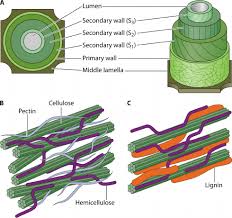
Cell to cell communication
Has connections between them called plasmodesmata
Allows communications and signals to occur between cells and transport of materials
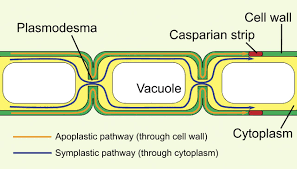
Whole plant structure
Have shoots that grow above ground
Roots grow below ground
Shoots consist of a stem, leaves, bear flowers and seeds
Roots function as storage organs and are most important for absorption of water and nutrients
Roots create large surface area
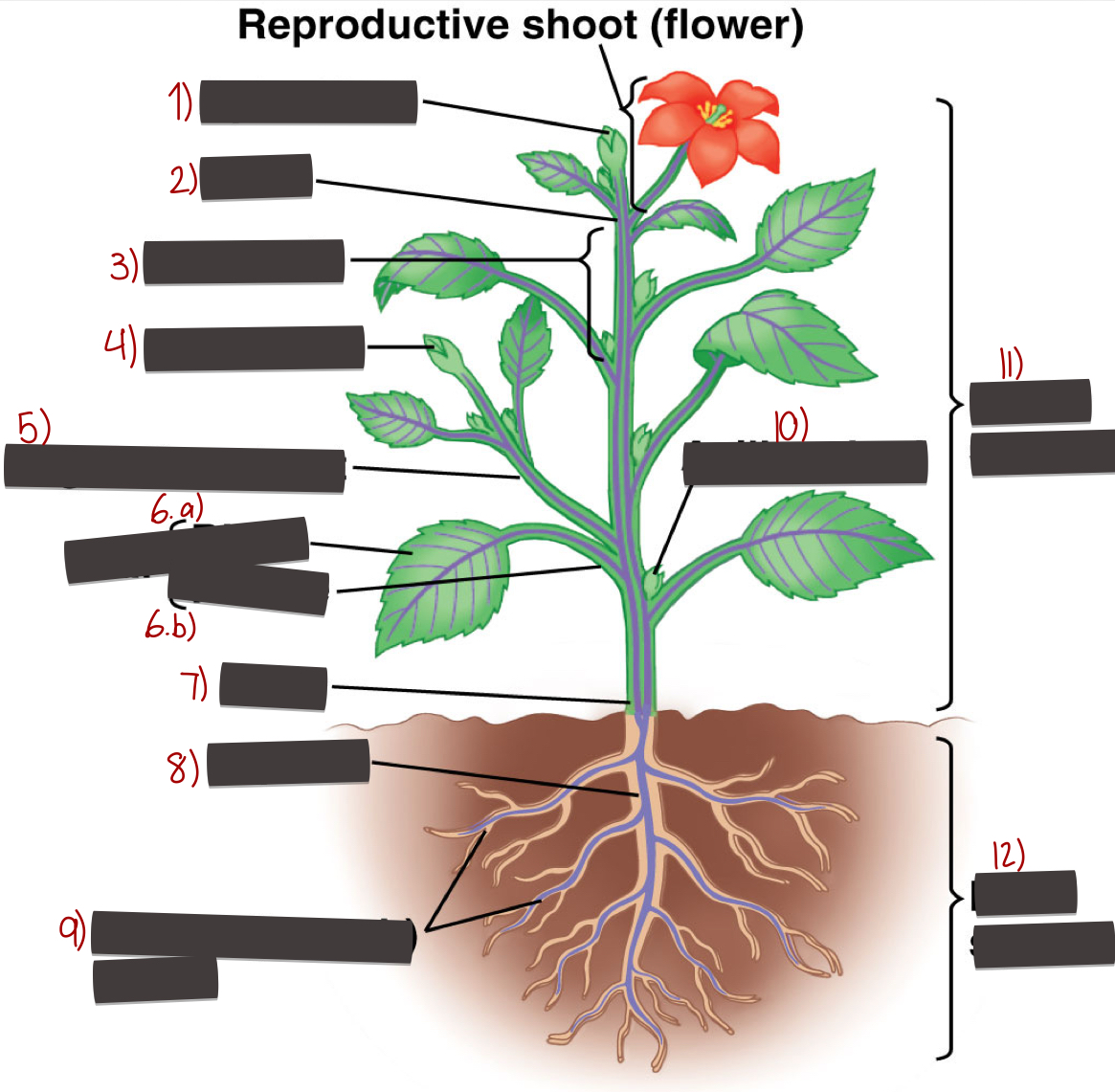
Whole plant diagram
Apical bud
Node
Internode
Apical bud
Vegetative shoot
a) Blade leaf
b) Petiole
Stem
Taproot
Lateral roots
Axillary bud
Shoot system
Function of leaves
Primary site of photosynthesis
Simple or compound in structure
Upper epidermis and a lower epidermis, in between are mesophyll cells - palisade mesophyll and spongy mesophyll
Cuticle on the surface that contain waxes that reduces water loss
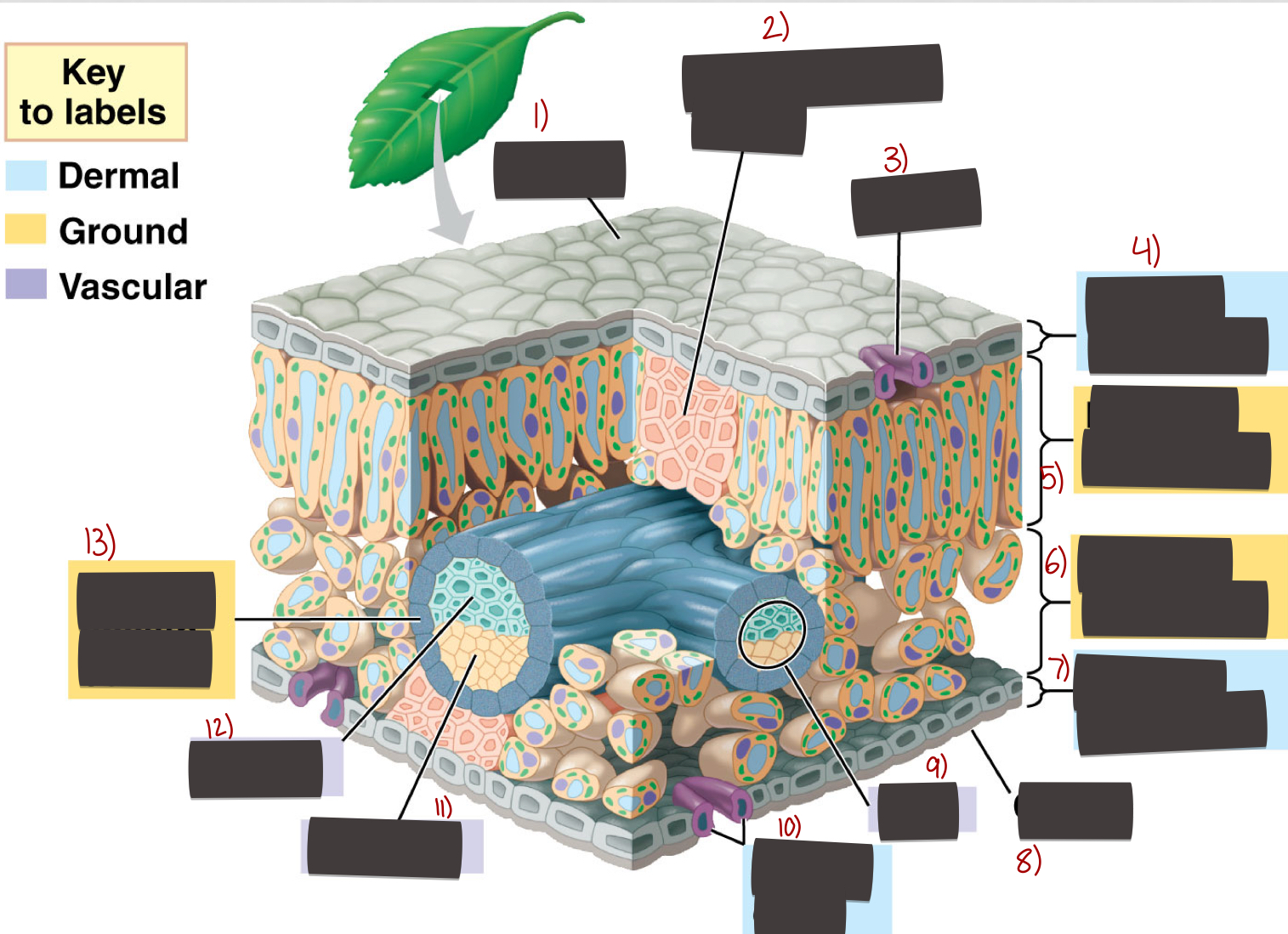
Diagram of a leaf
Cuticle
Sclerenchyma
Stoma
Upper epidermis
Palisade mesophyll
Spongy mesophyll
Lower epidermis
Cuticle
Vein
Guard cells
Phloem
Xylem
Bundle-sheath
Functions of stems
Provides physical support to the plant and are also involved in movement of water and nutrients up the plant through the vascular system
Allows for continued growth through the apical meristem
Contain axillary buds that give rise to side shoots
Used for storage of food and water
Allow for lateral growth to increase width of the stem
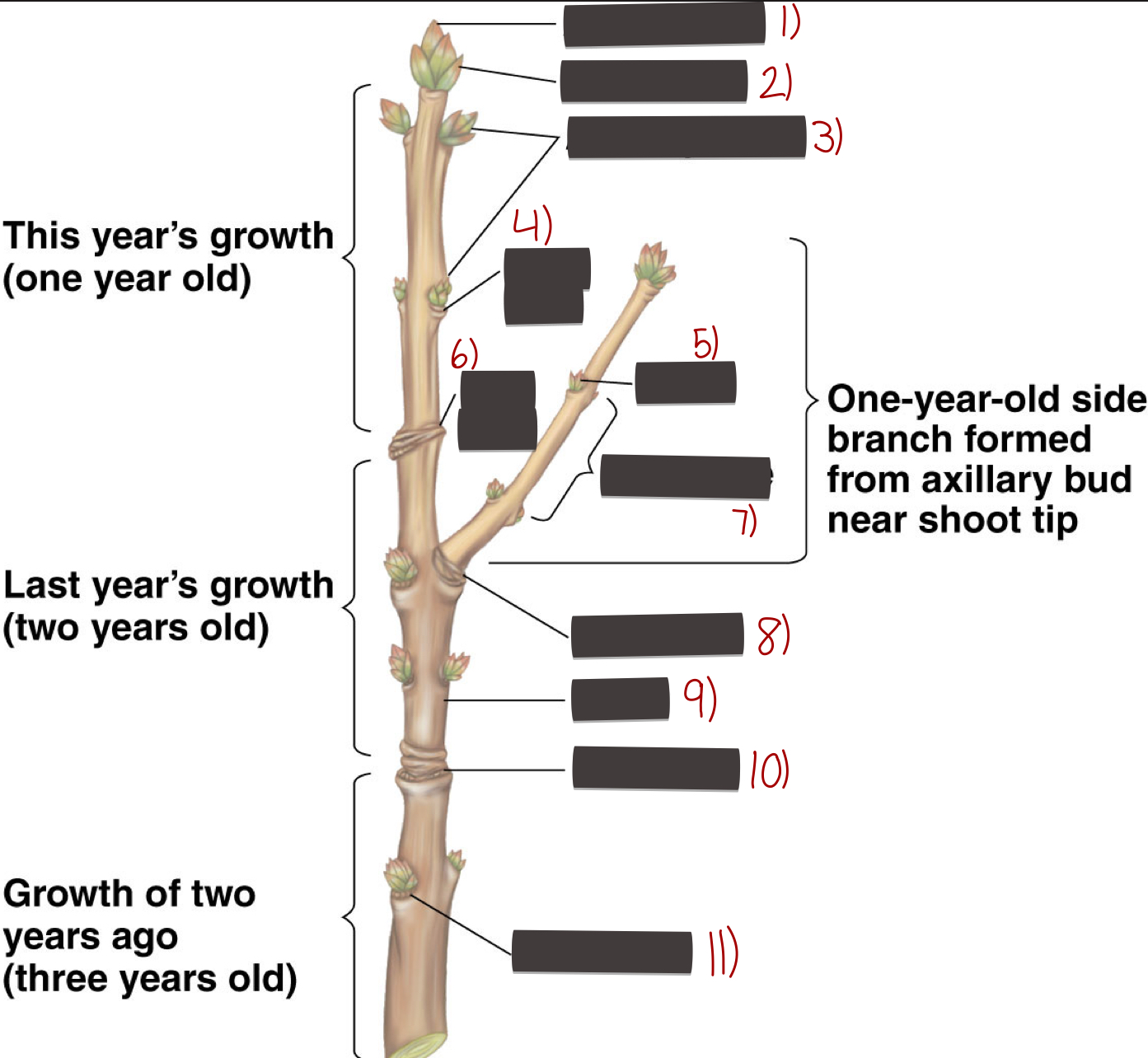
Diagram of shoot
Apical bud
Bud scale
Axillary buds
Leaf scar
Node
Bud scar
Internode
Leaf scar
Stem
Bud scar
Leaf scar
Meristem
Actively growing regions found a the tips of shoots and roots of plants allow for continued growth
Growth of side shoots from stems is also to axillary bud meristems
Expansion of width of stems is also due to the actively of lateral meristems, especially cambium
Functions of roots
Anchor the plant/tree in the soil
Absorb water and nutrients form the soil
Have a large surface area due to root hairs
Continued growth occurs through the root meristems
Used for storage of nutrients
Tissue types in plants
Dermal ; found on the outside layer of plant tissues provides protection to the plant
Meristematic ; found a the growing tips
Ground ; there are 3 types = parenchyma, collenchyma and sclerenchyma
Vascular ; there are two types = xylem and phloem
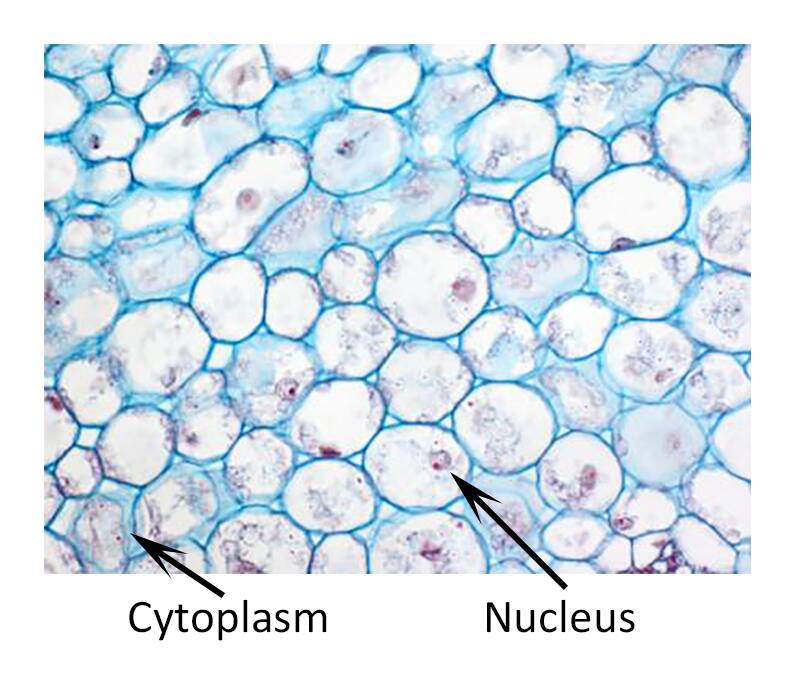
Parenchyma cells
Found in leaves, tubers
Constitute living cells
Involved in producing sugar during photosynthesis and they store food
Thin walls and large vacuoles
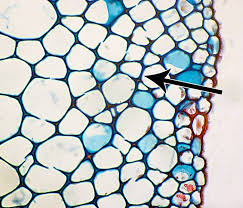
Collenchyma
Do not store food
Structural support to plants
Have thick walls
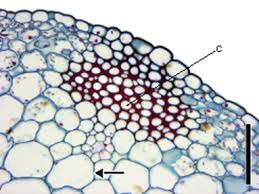
Sclerenchyma
Cell are non-living
Thick walled
Function in mainly providing support and rigidity to plants

Xylem tissues
Moves water and nutrients up the lant from roots through stems to leaves
Consists of cells called tracheid’s and vessel elements which have pores in them
Non living
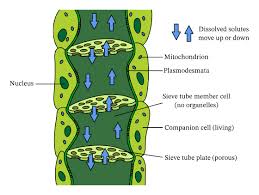
Phloem
Sugar and water solution from leaves to other parts of the plant
Consists of sieve tube elements and companion cells
Are living
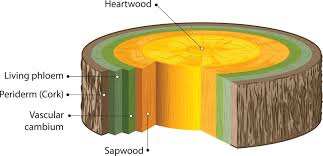
Vascular cambium
Ring of actively dividing cells found separating the xylem and phloem
Cell divisions result in the formation of secondary xylem and secondary phloem
Continuous division over the years caused formation of secondary xylem in larger trees
result in the formation of growth rings seen in large trees
Plant reproduction
Increase their numbers for the next generation
Reproduction may be asexual or sexual
In asexual reproduction the offspring are all genetically identical as this is clonal reproduction
In sexual reproduction there is the advantage of increasing genetic diversity
Sexual reproduction
Requires the fusion of male and female gametes to produce a zygote followed by seed production
Male gamete = pollen grains
Female gamete = ovules
Gametes are found in the flowers
For reproduction it requires the transfer of the male gamete to the ovules to initiate fertilization
Male gametes are produced in anthers
Female gametes are found in the ovary
Pollination and fertilization
Process of transfer of the male pollen to female stigma
Can be transferred by wind, this requires production of very large amount each spring
Can also be transferred by insects, are attractive and produce nectar to reward the pollinators
Steps in fertilization
Pollen grain has 2 sperm nuclei
Pollen grain germinates on the stigma of the same plant specie and produces a germ tube
Germ tube grown down the style
When it reaches the ovary it seeks out the opening in the ovule called a micropyle
One sperm nucleus fuses with the eff nucleus inside the ovule to form the zygote
Second sperm nucleus fuses with the 2 polar nuclei to form the endosperm
Called double fertilization
Development of zygote
Divides several times to form an embryo
Differentiates to form a root and shoot apex
Ovary expands and the wall become the seed coat
Each fertilized ovule forms one seed
Ovary wall can be fleshy
Each seed has one or cotyledons depending on it it is a monocot or dicot plant species
Seeds will germinate to form a root and shoot and the plant has now been propagated sexually
Self pollination
Where pollen from the same flower fertilizes ovules from the same flower
More efficient as the pollen and ovules are found in the same flower
Cross-pollination
Where pollen from one flower fertilizes ovules from a different flower
Less efficient but evolutionary more advantageous as more genetic diversity is created
Plants have developed mechanisms to try and increase cross-pollination
How can plants increase cross-pollination
Involve more than one method of pollen transfer
Make the male and female flowers separate on the same plant. All use wind pollination and are called monoecious
Make the male flowers mature earlier than female flowers
Produce male and female flowers on different plants
Make the male pollen incompatible with stigmas of the same plant
How to spread seeds far and wide
For survival plants must be able to produce lot’s of seeds and spread them as far as possible
This allows opportunity for survival in a different
Evolved different methods to spread seeds
Make lots of seeds that spread by wind
Make seeds float on water
Make seed spiny so that catch to animals and humans
Make seeds aerodynamic
Make Fruits attractive so seeds inside them are spread
Make fruits fleshy and attractive for animals toe at
Why do some plants not produce seeds
Most plants are diploid like in humans allowing normal meiosis to occurs and gamete production
Some plants are polyploid with greater than 2 sets of chromosomes
These plants cannot pair chromosomes in meiosis causing no gametes to form therefore no seeds are produced
Bana is a triploid
Potato is a tetraploid
Strawberry is an octoploid
Roots take up water
Roots take up water through osmosis ; movement of water from a concentration of low solute to one of higher concentration of solute
The root hairs provide greatly increased surface area for absorption of water and nutrients
Root hairs provide greatly increased surface area for absorption of water and nutrients
Once water enters the root it can move in between cells (apoplast) or through the cells themselves (symplast)
Once it reaches a layer of cells called the endodermis the water is redirected to move via the symplast
Allows for control of water uptake
Endodermis is the casparian strip which is how water movement is regulated
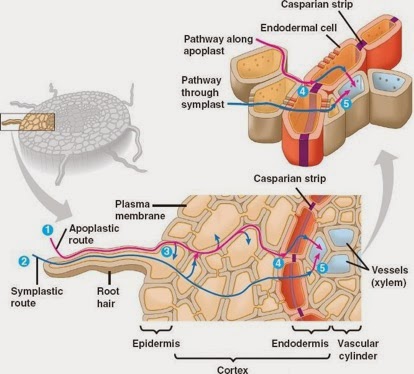
Water movement
Once inside the xylem tracheids and vessel elements, water molecules adhere to each other by hydrogen bonding as well as to the walls of the xylem vessels
Creates a column of water internally
Water travels upwards to the leaves
Rate of travel can be 15 metres per hour in a large tree
Water flow up the plant (tree)
Loss of water due to transpiration creates a “water deficit” or negative water protentional inside the leaf
This causes a “pull” of water into the leaf from the xylem. This in turn pulls water up the xylem from the roots
The “transpiration pull” is the main force that causes water to move up the plant from roots to leaves
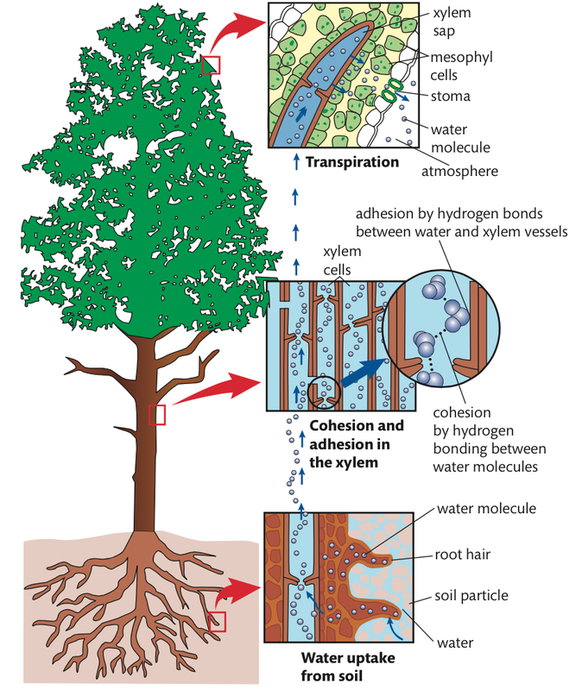
The functions of stomata
Found in the epidermal layer of leaf cells
More on the underside of leaves compared to the upper surface as they as not exposed to direct light and it is cooler
Guard cells regulate the stomatal opening size
The larger opening the more water will be lost
Open when there is lots of water when there is sunlight and when potassium ion levels are high inside guard cells
Will close when there id not enough water when it is dark and when potassium levels are low
How do plants adapt in desert environments
Have reduced leaf size and fleshy leaves to store water
Some close the stomata during the day and open them at night when its cooler
May be located deeper inside the leaf than in the epidermis
Leaves have thick waxy cuticles to retain water
Causes CO2 levels in leaf cells to decline and oxygen builds up
Calvin cycle slows down as there is less CO2
Plants undergo “photorespiration” where the presence of oxygen the phosphoglycerate molecule is oxidized to release CO2
This causes up to 50% of the carbon to be lost
to avoid this loss plants have evolved a C4 pathway to fix the carbon in hot climates
Are called xerophytes
Function of the phloem
During photosynthesis sugar is produced in the leaves that must be transported to other parts to the plant
This requires movement from the source to where it is needed for growth
Sucrose is “loaded” into the phloem cells by sucrose transporters this causes a high osmotic pressure which draws in water from the xylem
Causes pressure to build up which forces the flow of sugar down the plant
Turgor pressure causes the sugar solution to move via “bulk flow” to reach cells that need it

Plants response to physical injury
Injury causes cells to break and release contents
Enzymes are produced to heal the the injury
Oxidative reactions cause browning that helps heal the wound
Other chemical reactions occur to start the process of cell division

Plant stresses cause chemical changes
Environmental or biological stresses will cause plants to express genes to produce chemical produces to deal with the stress
Response may occur in a matter of minutes chemical signals are produced
Which signal other parts of the plant that something is going on
This in turn can cause other changes to help the plant recover from the stress
Plants do respond to their environment
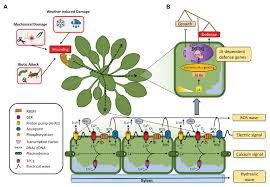
Gravitropism
Plants respond to gravity
Positive ; roots grow down
Negative ; stems grow against gravity
Thightropism
Thigma means touch in greek
If you touch certain plants this changes the plants behavior
Photoperiod
Plant responses to different lengths of time of exposure to light
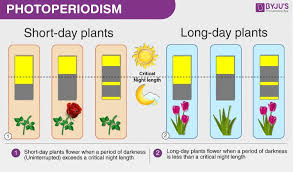
Phytochrome
Protein sense light
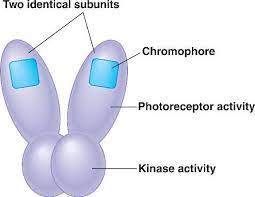
Photosynthesis
Production of sugar in plants using carbon dioxide and water in the presence of light
Solar energy is used to produced chemical energy which is used to produce organic molecules
6CO2 + 12H2O => C6H12O6 + 6H20 + 6O2
Takes place in plants and trees
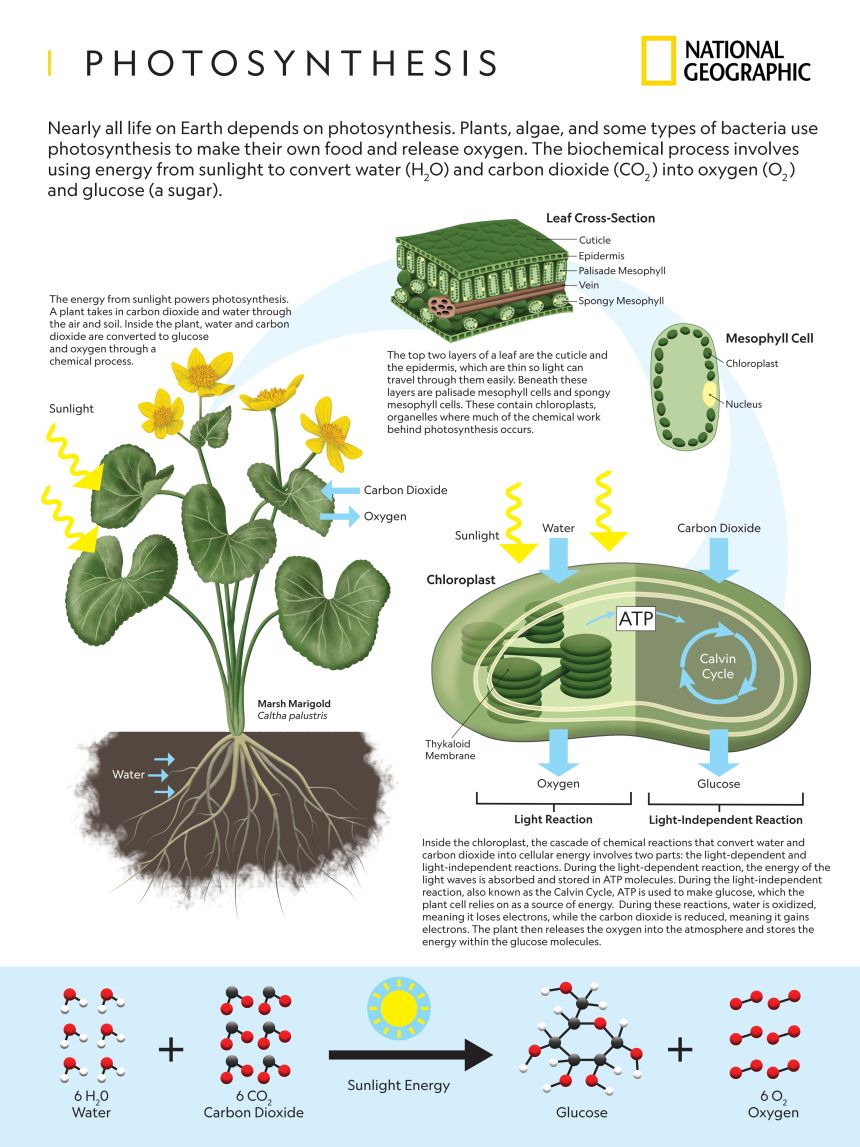
Chlorophyll and pigments
Only respond to light in the visible spectrum
Two forms of chlorophyll - ‘a’ and ‘b’
Other pigments that are orange and yellow called carotenoids (absorb light around 480-500 nm)
Chlorophyll ‘a’ absorbs light around 440nm and also at 680nm-700nm
Carotenoid pigments show up when chlorophyll is broken down in the fall season to produce vivid colors of leaves
They are anti-oxidants that reduce oxidative damage due to sunlight and UV rays
Features of chloroplasts
Chlorophyll is contained within
Found in the mesophyll cells of leaves
They are surrounded by a double layer of cell membranes inside the chloroplasts are stacks of granum that are surrounded by the thylakoid membrane
Light is absorbed by the granum except for green wavelength which is transmitted
Light energy is packaged into photons which strike the chlorophyll and causes it to emit higher energy level electrons
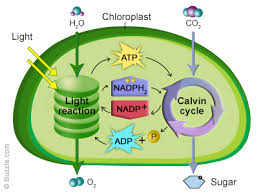
Photosynthetic reactions
During light reactions ADP and NADP are combined with P to form ATP and NADPH this provides energy for the next step of photosyntheis
Oxygen is released from water
Next step is the calvin cycle which is light independent in which energy form the light reactions is used to drive the formation of carbon molecules from CO2
The chlorophyll and pigment molecules are arranged in a light-harvesting complex called a photosystem, inside is a primary electron acceptor called pheophytin
the photosystem I and photosystem II are embedded in the thylakoid membrane

The photosystems
Photosystem I absorbs light in the range of 700 nm
Photosystem II absorbs light in the range of 680 nm
Electrons released from the splitting of water by light photons reach P680 first and the chlorophyll energizes electrons to the primary electron acceptor
The electrons are transferred down an “electron transport chain” to Plastoquinone (Pq), then to Cytochrome complex (Cc) and then to Plastocyanine (Pc)
At this point of reaching Cc, energy from the electrons is used to generate ATP
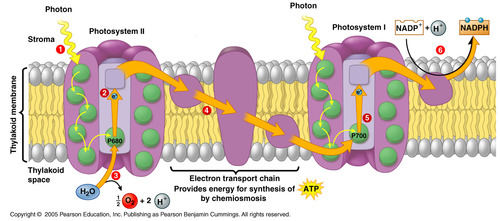
Electron transport chain
Light energy then strikes PS I (P700) and electrons are transferred to the primary electron acceptor
Electrons continue down the electron transport chain to the next molecule which is Ferredoxin (Fd)
The energy from the electrons creates the formation of NADPH reductase
End result of electrons being released from water is the production of ATP and NADPH and the production of oxygen
Cyclic electron flow
Cyclic electron flow occurs when electrons from ferredoxin are transferred back to cytochrome complex instead of moving on to NADPH reductase
This results in no NADPH being formed but ATP is still produced
The cells would undergo cyclic electron flow if there was sufficient NADPH present of it the cells needed more ATP to be produced
ATP production occurs via ATP synthase which is driven by a flow of protons through the thylakoid membrane and into the stroma of the chloroplast, this is called chemiosmosis
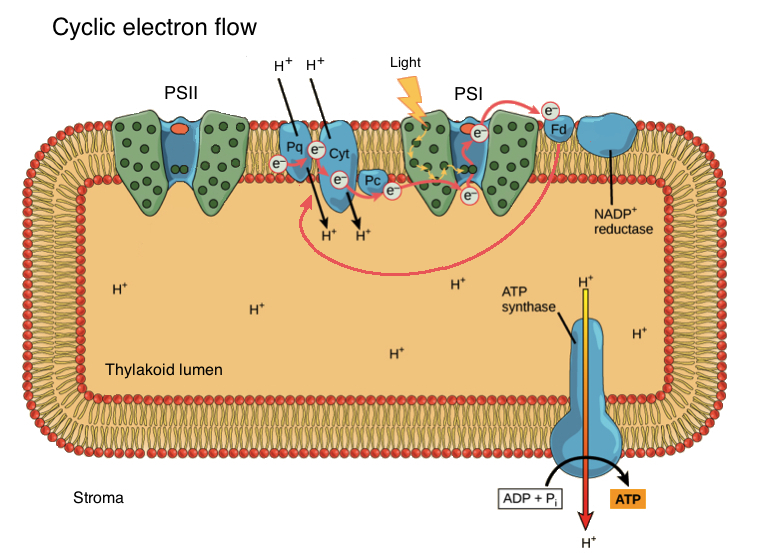
Calvin cycle
Also called the C3 cycle
results in the conversion of carbon dioxide to sugar using energy from the light reactions
Also called “carbon fixation”, about 160×10^12 kg/yr is fixed by plants
Occurs in the stroma of chloroplasts
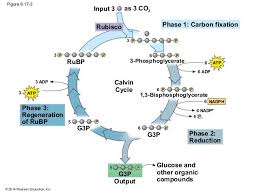
Steps of the calvin cycle
Reaction starts with rulose-1,5-biphosphate adding CO2 molecule to form (2X) 3-phosphoglycerate
Enzyme involved here is called Rubisco = ribulose-1,5-biphosphate carboxylase
The next step is a requirement for STP to produce 1,3-biphosphoglycerate (3C)
NADPH is required to form glyceraldehyde-3-phosphate this goes on to form sugar
RuBP is reformed to continue the cycle
Energy in the form of ATP is required here
Total energy required for producing a 6C sugar molecule is 18 ATP molecules and 12 NADPH
Hormones respond ot environmental changes
Auxin - stimulates cell elongation and regulates branching and organ bending
Cytokinins - stimulate plant cell division and promote later bud growth
Gibberellins - Promote stem elongation, helps seed break dormancy and used stored reserves
Brassinosteroids - Chemically similar to the sex hormones of animals, induce cell elongation and division
Abscisic acid - produces stomatal closure in response to drought, promotes seed dormancy
Strigolactones - regulate apical dominance, seed germination and mycorrhizal associations
Ethylene - Mediates fruit ripening
The C4 pathway in plants
Molecule of malate (C4) instead of phosphoglycerate (C3)
This is produced in mesophyll cells by adding CO2 to a molecule of phospho-enol-pyruvate (PEP) to form oxaloacetate which is converted to malate
Enzyme involved is PEP carboxylase which has a higher affinity for CO2 than Rubisco and so can capture lower concentration of OC2 in hot climates
These plants also have specialized cells called “bundle sheath cells” These cells break down malate to release CO2 and form pyruvate
This CO2 molecule is used in the Calvin cycle to form sugar this allows plants to grow in hot climates
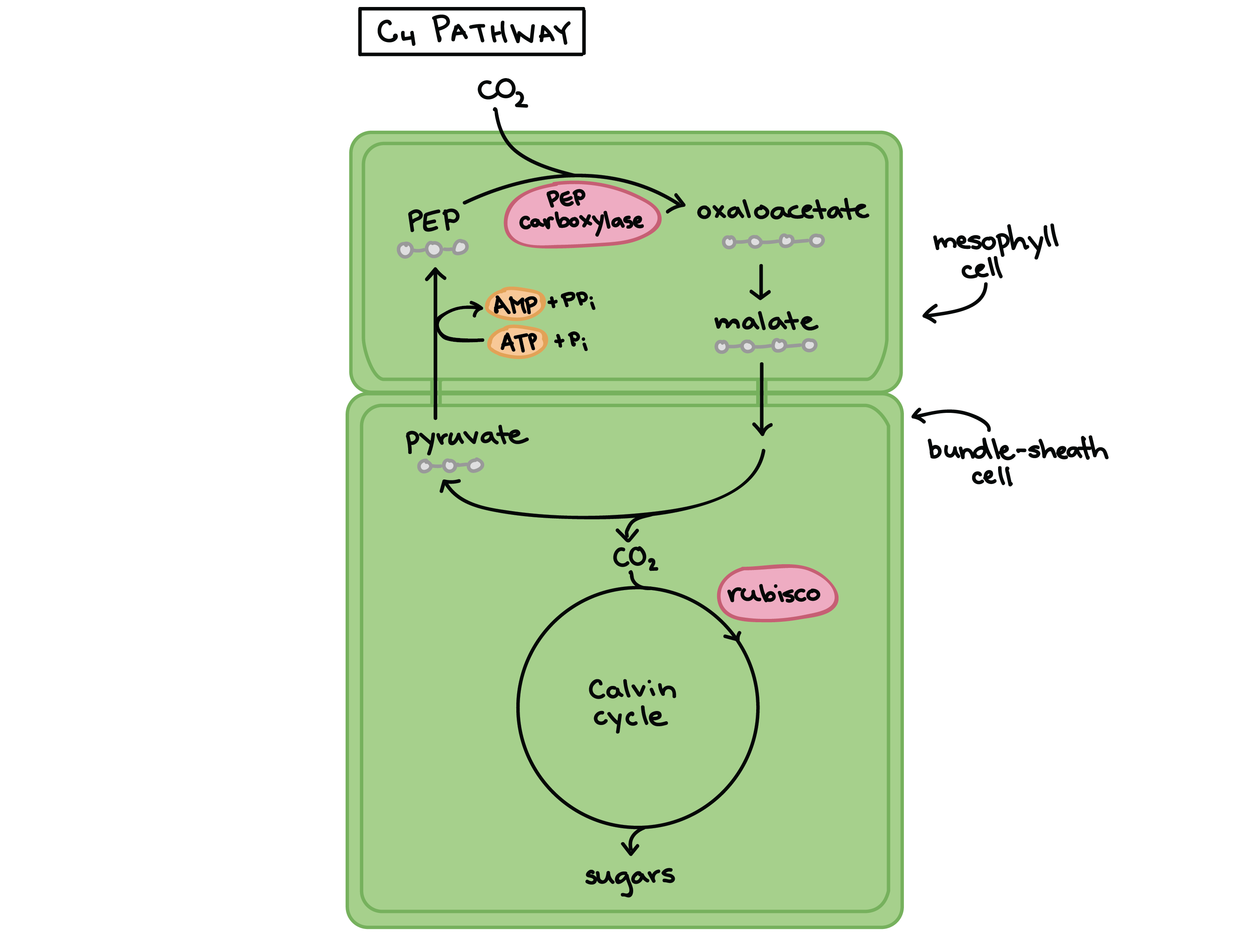
CAM plants
These are Crassulacean Acid Metabolism plants
Occur in plants such as cactus and pineapple
During the day stomata are closed
CO2 is taken up at night to produce organic acids
This is stored in mesophyll cells at night
Day time, light reactions continue and ATP and NADPH are produced
Then crassulacen acid is broken down to release CO2
Used in the Calvin cycle which can operate while the stomata are closed during the day